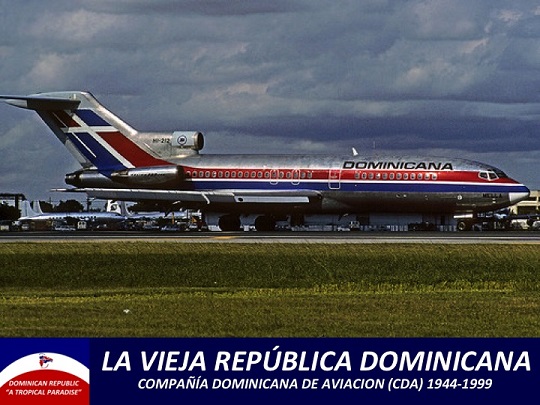 CDA/Dominicana de Aviación
CDA/Dominicana de Aviación

CDA/Dominicana de Aviación
Dominicana was established in 1944 in an effort to create a national airline aiming at the large number of Dominican citizens who emigrated to the United States, Puerto Rico and Spain. The initial fleet consisted of the Douglas C-47 and DC-6. During the 1950s, Dominicana launched a domestic route network to places such as Puerto Plata, La Romana and Santiago de los Caballeros, acquiring Curtiss C-46 Commando and Aviation Traders Carvair airplanes. In 1960, the airline was operating international nonstop passenger service between Ciudad Trujillo (the capitol of the Dominican Republic which was later renamed Santo Domingo) and Miami with Douglas DC-4 propliners and also nonstop between Ciudad Trujillo and San Juan, Puerto Rico with Douglas DC-3 and Curtiss C-46 prop aircraft.[1] Later during the 1960s, Dominicana renewed its fleet with the Douglas DC-8, McDonnell Douglas DC-9 and Boeing 727 jetliners. The route network was further expanded, with more destinations in the Americas and the Caribbean during the 1970s. At its height in the 1980s, Dominicana operated the Boeing 747 to European destinations like Madrid, Milan, and Frankfurt.
At the end of the decade, the airline's economic situation worsened due to poor management, lack of innovation or cost-cutting culture, and the heavy maintenance costs of its aging fleet. More importantly, on the revenue side, government employees also sought to fly non-revenue, given the typical patronage in the Dominican Republic with many flights full of them often displacing paying passengers. Subsequently, the fleet and network were scaled back, leaving only the original routes like New York, Miami, Caracas, and San Juan. In an effort to save on maintenance costs, Dominicana began to operate leased aircraft (mostly Boeing 727s and also Airbus A300s). The financial situation further worsened into the 1990s, which coincided with a negative customer reputation (like lost or delayed luggage as well as unreliable schedules). In 1994, now also faced with Cat1 restrictions in the US, Dominicana wet-leased a Boeing 737-300 and a Boeing 757-200 from Mexican low-cost airline TAESA. Further aircraft were wet-leased from Express One International, Atlantic Aviation and Carnival Air Lines. During Christmas of 1994, many Dominicana VFR passengers were stranded at JFK, MIA, and SJU when the airline was unable to provide necessary funding to lessors for heavily-booked Christmas flights (and, overbooked for the B727 the lessors were providing, since an A300 had been expected to be wet-leased). As a consequence of the outrage, in early 1995 the government of the Dominican Republic decided to shut down the airline. While the shutdown was originally only planned as a temporary measure to get re-organized, the company never became operational again. The vice president at the time was quoted saying that "Dominicans can fly APA Internacional" which was another "local" airline that benefited handsomely from Dominicana's demise. While several attempts have been made to privatize the airline, no efforts came to fruition. American Airlines and later JetBlue dominated the market and the business case for a new Dominican flag carrier is relatively weak given the investment that would be required and the debts that would have to be honored in order to use the Dominicana name
